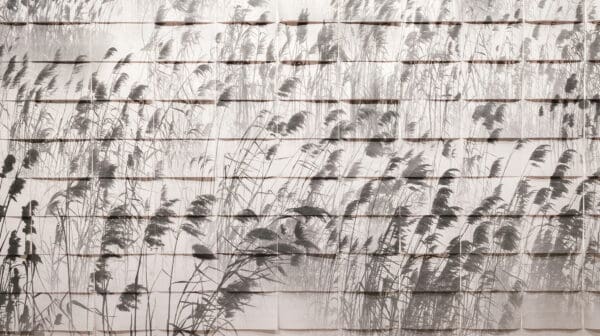
Poetics of Relation
Tender Comrade, currently on show at Sydney’s White Rabbit Gallery, creates a new vocabulary of queer kinship by reimagining the relationship between artworks, bodies and space.
Like many of us, Andrew Frost is spending a lot of time literally on the couch clutching his phone. He contemplates the valuable generosity of both sharing and creating culture on social media, making the world a tiny bit better.
Scroll, scroll, scroll. Up and down the newsfeed, posts and pics and videos. Some original but most shared, and who knows where they come from. Back to the top. Five minutes off and then back ‘round again.
During the lockdown the only major social interaction most of us are having (outside our families or flat mates) is on social media. And it seems more pressurised than usual, with provocative opinion pieces, hot takes, breaking news and think pieces being circulated at an accelerated pace.
While I have a lot of respect for all those writers who have decided to embark on Covid-19 journals, or lengthy political think pieces on what exactly all this means, what we’re really looking for is diversion from reality.
Instead we’re getting an intensification of it – more of the same that feels a lot like… more of the same.
Social media is an odd thing.
Under normal circumstances our addiction to various social media platforms is leavened by our participation in what we laughably call ‘real life.’ Talking to people, going places, working, looking at things in shops, museums, and galleries – all that is diversion from the clamouring non-stop feed spooling away on our devices, a chorus on everything from the mundane to the pseudo-profound.
And as a moderate to heavy user of social media I can attest to the fact that, under normal circumstances, social media does not make me happy. Indeed, most of the time it makes me slightly to moderately depressed.
Attempts to liven up dead social media experiences on platforms like Facebook, with all those endlessly circulating posts of top 10 books (covers only, no commentary) or top 10 albums (again, no context please) or whatever, only serve to reinforce marketing algorithms lurking behind the scenes. Indeed, that whole social media experience is a very subtly attenuated marketing campaign striving for the holy grail of earned media (where users ‘organically’ circulate IP without being paid for it).
But it also makes you realise just how valuable sharing positive cultural content can be. My subjective measure of this is that every time I encounter something online that’s offered up for the sake of just looking and sharing – be it art, video, a collection of images, GIF animation, a whole forgotten visual culture – I feel immeasurably better after engaging with it than I do when reading some half-baked critique or sh*t post designed for clicks.
There is generosity in sharing things you love, or even just merely ‘like’ on social media. Sure, there’s no escaping the way mere participation adds value to the platform, but as with most things we can easily ignore the everyday absurdities and contradictions and get small enjoyment in our collective isolation, both through recognition and through discovery. Who among us has not thrilled to the sporting competition of two Labradors? Toured through a spooky dead motel? Or delved into a bizarre photographic archive?
In the act of sharing, there’s an affirmation of the value we place on the notion of culture. On social media, it often feels that that culture is built moment to moment, and dissolves just as soon as we put our phones down. The experience of what we’d call ‘substantial’ is, if not impossible, then extremely rare.
But because we are also so attuned to the immediate fix, the notion that culture is something that is a cumulative project is easily forgotten. Building a culture over time is valuable. In this context, the humble JPG, GIF or mv4 becomes an agent in the propagation of a world view, a political position on aesthetics, on social relations and cultural possibilities.
The key to making social media and sharing a positive experience is to apply a rigorous curatorial approach to your feed.
As a consumer, it’s important to fill up your social feed with good stuff, by following artists, writers and directors, museums and galleries. You might also consider following hashtags rather than individuals, as it helps to weed out lots of negative junk. Following subjects is also a great way to lift your content feed from humdrum politics to a kind of online flip book of interesting stuff, much of it presented without a particular agenda attached.
But perhaps more importantly than being an enlightened consumer is being a proactive producer.
One of the upsides of the recent shutdown for me has been the opportunity to delve into the deep wells of knowledge on Twitter where scholars, academics and practitioners across a wide range of topics and disciplines offer up long threads of tweets; mini essays written from a point of view supported by years of expertise, illustrated with GIFs, videos and numerous links for further reading.
And you can do this too. There, mere celebration of things that you like are consequential contributions to cultural dialogue. To say this is good – to recommend a great movie, a work of art, a book, and to give your response some context and reflection – helps avoid the quick fix response of most social media. Refrain from the negative take, the “I’ve-seen-this-and-I-hated-it response” in a thread of people communally enjoying a shared interest. Take it from someone who once specialised only in hot takes – it does no one no good; not you, or anyone else.
If you want to feel good about the world again, then you have to contribute to making it a tiny bit better, one post at a time.